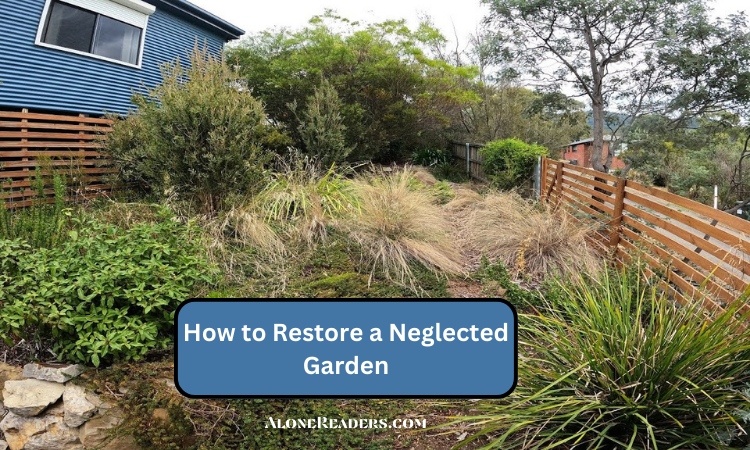
Anyone can face a neglected garden, regardless of recent home moves or just looking outside for the first time in months. It's terrible. Where should you begin when faced with overgrown plants, unruly trees, and more weeds than lawns?
What equipment and materials are required for reviving your garden? Consider the following as a starter:
But based on the nature of your work, you can require a wide range of specialized tools, such as chainsaws and industrial diggers.
Below is our suggestion on how to rejuvenate a neglected garden because there are a few considerations to make and that preparation is essential:
Be consistent
If you can, wait a full year before starting. Think about the garden throughout the year, including when it is vibrant and when it is shaded. What currently appears to be a collection of dead twigs may in the spring blossom into a gorgeous tree.
Make a to-do list and a budget
Keep a close eye on your garden and list the tasks you want to finish as you go to get to know its personality. For example, which trees are the most numerous and need to be removed, and which plant do you want to maintain or turn into a feature?
Order the tasks in your list after the complete list. Also, figure out the amount of money you'll need to put away in order to make these improvements.
Create space
When you're ready to take care of your garden, you must clean up the area first. Planning your new garden will be simple once you are aware of the resources you have available. You'll be able to design your new garden a lot more easily because you'll know exactly what you have to deal with. Winter is a good time to carry out this task. Any organic material you clear for future use should be composted.
Leave the trees alone
Cut back overgrown weeds and hedges, but first be cautious with the trees. Reduce weed and hedge growth, but postpone tree cutting for now. It's challenging to locate an appropriate substitute for them because they take a long time to grow and become established, and they can be challenging to totally remove.
Select which plants to keep
Any plant you don't want is a weed, therefore pull it up. Just handle them gently and keep in mind that you can shift plants if you'd prefer to have them somewhere else. Along with saving you time, this will also enable you to save money.
Take it a step at a time
The most obvious results, which may be a great source of inspiration, can be obtained by attentively tending to one area of your garden at a time.
Keep the original idea in mind as you construct decks, raised beds, and storage facilities.
Prune
They should be pruned and trimmed to eliminate any dead or broken branches, restore their shape, and encourage wholesome development. Using the right pruning methods will promote new growth, improve airflow, and improve your garden's overall beauty.
Lawn rejuvenation
The condition of your grass will depend on how long your garden has been neglected. Start by cutting the grass short and tidying up the edges. Then, if any bare spots remain, reseed them or install fresh turf where more grass is required.
Understand your budget
Be cautious of your budget before you go beyond expenditures to prevent costs from spiraling out of control and putting the project on hold. Planting is usually inexpensive, especially if you start from seed. However, landscaping may become very expensive, especially for large areas.
Choose a theme
You must decide on a unifying theme for your garden if you want to transform it from ordinary to extraordinary. You can get ideas for your own garden by visiting and watching gardening shows & exhibits.
Finishing touches
Finally, you can begin transforming your garden into the space of your dreams. Clean off the dust before painting and varnishing the wood.
Fill in the flower beds' empty spaces. To make the edges look clean, trim them a little. Decorate it to make a statement and furnish it to make it more comfortable.
Naturally, you want to prevent the garden from ever reverting to its initial state once the hard job has been completed. Simply said, you need to control everything that starts to grow out of control. This is what gives the garden an overgrown appearance and can make plants overcrowd and decay. Make sure you periodically mow the lawn and trim the edges. Every year, prune trees and plants as needed. Unfortunately, weeds can't be avoided, so set aside some time each week to remove them.
Apart from that, you simply need to take care of the non-living things as you would your own home. Keep the patios, furnishings, and fences tidy. Your chairs and tables will be shielded from the weather with furniture covers. Give woodwork a fresh coat of paint whenever necessary to keep it looking good. Try different colors and designs with your flowers. It's important to keep this in mind while developing your garden if too much maintenance sounds overwhelming. Make decisions that will simplify your life later on. Hardy plants won't need as much of your attention and may usually be left to fend for themselves. Curved lawns take longer to cut down than straight ones, or perhaps you'd like artificial grass to completely solve the problem.
Final Word
Has the once-vibrant garden you previously had become neglected? Don't lose hope! Your garden can be restored with a little patience, work, and skill. A planned approach is needed to rejuvenate neglected gardens so that their beauty and vitality are returned.